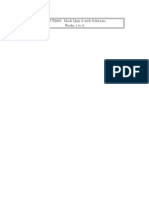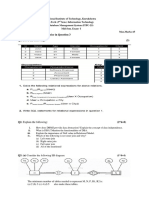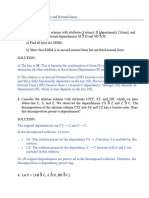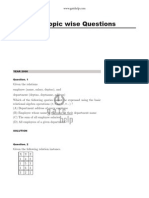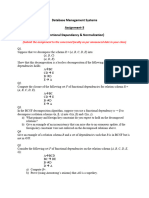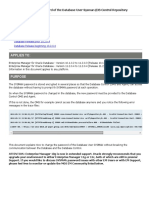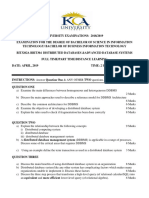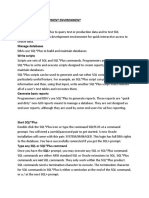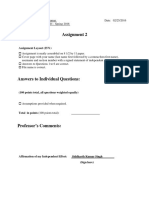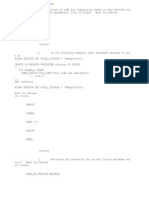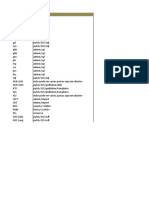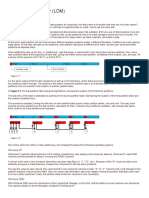DBMS Gate Questions - Functional Dependencies and
Normalization
Functional Dependencies and Normalization Questions
1. Consider the following relational schema along with all the functional dependencies that hold on them.
R1(A, B, C, D, E) : {D → E, EA → B, EB → C}
R2(A, B, C, D) : {A → D, A → B, C → A}
Which of the following statement(s) is/are TRUE?
[GATE CSE 2025 Set 2]
(A) R1 is in 3NF
(B) R2 is in 3NF
(C) R1 is NOT in 3NF
(D) R2 is NOT in 3NF
2. Consider a relational schema team(name, city, owner), with functional dependencies ∀ name → city,
name → owner.
The relation team is decomposed into two relations, t1 (name, city) and t2 (name, owner). Which of
the following statement(s) is/are TRUE?
[GATE CSE 2025 Set 1]
(A) The relation team is NOT in BCNF.
(B) The relations t1 and t2 are in BCNF.
(C) The decomposition constitutes a lossless join.
(D) The relation team is NOT in 3NF.
3. A functional dependency F : X → Y is termed as a useful functional dependency if and only if it
satisfies all the following three conditions:
• X is not the empty set.
• Y is not the empty set.
• Intersection of X and Y is the empty set.
For a relation R with 4 attributes, the total number of possible useful functional dependencies is
[GATE CSE 2024 Set 2]
1
�4. Which of the following statements about a relation R in first normal form (1NF) is/are TRUE?
[GATE CSE]
(A) R can have a multi-attribute key
(B) R cannot have a foreign key
(C) R cannot have a composite attribute
(D) R cannot have more than one candidate key
5. The symbol → indicates functional dependency in the context of a relational database. Which of the
following options is/are TRUE?
[GATE CSE]
(A) (X, Y ) → (Z, W ) implies X → (Z, W )
(B) (X, Y ) → (Z, W ) implies (X, Y ) → Z
(C) ((X, Y ) → Z and W → Y ) implies (X, W ) → Z
(D) (X → Y and Y → Z) implies X → Z
6. Suppose the following functional dependencies hold on a relation U with attributes P, Q, R, S, and T:
P → QR
RS → T
Which of the following functional dependencies can be inferred from the above functional dependencies?
[GATE CSE 2021 Set 2]
(A) P → R
(B) P S → T
(C) R → T
(D) P S → Q
7. Consider the relation R(P, Q, S, T, X, Y, Z, W) with the following functional dependencies.
PQ → X
P →YX
Q→Y
Y → ZW
Consider the decomposition of the relation R into the constituent relations according to the following
two decomposition schemes.
D1 : R = [(P, Q, S, T ); (P, T, X); (Q, Y ); (Y, Z, W )]
D2 : R = [(P, Q, S); (T, X); (Q, Y ); (Y, Z, W )]
2
� Which one of the following options is correct?
[GATE CSE 2021 Set 1]
(A) D1 is a lossy decomposition, but D2 is a lossless decomposition.
(B) Both D1 and D2 are lossless decompositions.
(C) Both D1 and D2 are lossy decompositions.
(D) D1 is a lossless decomposition, but D2 is a lossy decomposition.
8. Consider a relational table R that is in 3NF, but not in BCNF. Which one of the following statements
is TRUE?
[GATE CSE 2020]
(A) A cell in R holds a set instead of an atomic value.
(B) R has a nontrivial functional dependency X → A, where X is not a superkey and A is a non-prime
attribute and X is not a proper subset of any key.
(C) R has a nontrivial functional dependency X → A, where X is not a superkey and A is a non-prime
attribute and X is a proper subset of some key.
(D) R has a nontrivial functional dependency X → A, where X is not a superkey and A is a prime
attribute.
9. Let the set of functional dependencies
F = {QR → S, R → P, S → Q}
hold on a relation schema X = {P QRS}. X is not in BCNF. Suppose X is decomposed into two
schemas Y and Z, where Y = {P R} and Z = {QRS}.
Consider the two statements given below.
(I) Both Y and Z are in BCNF
(II) Decomposition of X into Y and Z is dependency preserving and lossless
Which of the above statements is/are correct?
[GATE CSE]
(A) I only
(B) Neither I nor II
(C) II only
(D) Both I and II
10. Consider an Entity-Relationship (ER) model in which entity sets E1 and E2 are connected by an m :
n relationship R12 . E1 and E3 are connected by a 1 : n (1 on the side of E1 and n on the side of E3 )
relationship R13 .
E1 has two single-valued attributes a11 and a12 of which a11 is the key attribute. E2 has two single-
valued attributes a21 and a22 of which a21 is the key attribute. E3 has two single-valued attributes a31
and a32 of which a31 is the key attribute. The relationships do not have any attributes.
3
�If a relational model is derived from the above ER model, then the minimum number of relations that
would be generated if all the relations are in 3NF is .
[GATE CSE 2015 Set 1]

